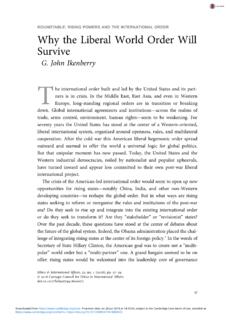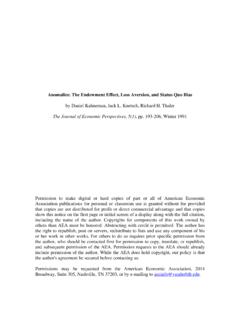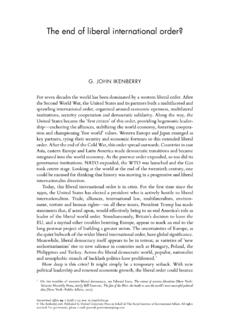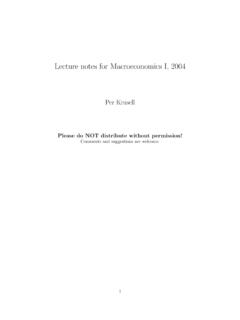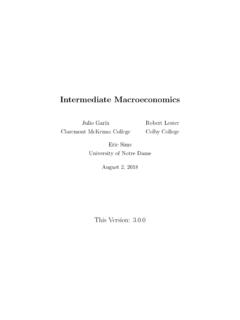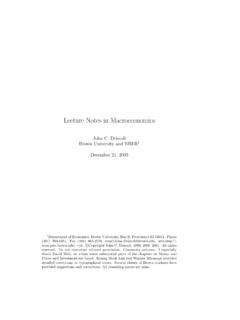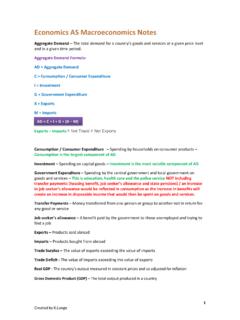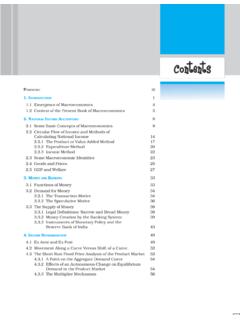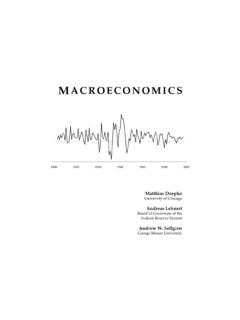Transcription of Asset pricing I: Pricing Models - Princeton
1 1 Asset Pricing I: Pricing ModelsMarkus K. 2014/2015 Contents1 Market Efficiency .. Ratio and StockPrices .. and Book to Market as driversof Stock Returns .. and Losers .. Studies .. Bonds .. Bonds .. Pricing .. Stocks and Macroeconomic Factors .. Risk with Covariance . The 2013 Nobel Prize in Economics ..212 CONTENTS32 One Period General Security Structure .. Derivatives .. Contracts .. Back to Security Structures ..333 Pricing in the One Period Forwards Revisited .. Forwards .. Options Revisited .. Price Boundaries .. to Expiration.
2 Price .. Back to the One Period Model .. Prices .. Fundamental Theorem of Fi-nance .. Prices and Incomplete Mar-kets .. Asset Pricing Formulas .. Price Model .. Discount Factor .. Martingale Measure .. Beta Model .. Recovering State Prices from Option Prices484 Risk Preferences and Expected Utility State-by-State Dominance .. Stochastic Dominance .. Von Neumann Morgenstern Expected Util-ity Theory .. Representation of Preferences .. Risk Aversion, Concavity, Certainty Equiv-alent .. Measures of Risk Aversion .. Risk Aversion and Portfolio Allocation.
3 Alternative Theories .. Savings .. Mean-Variance Preferences ..73 CONTENTS55 General Equilibrium, Efficiency and theEquity Premium Pareto Efficiency .. The Sharpe Ratio, Bonds and the EquityPremium Puzzle .. Adding Expected Utility .. The Equity Premium Puzzle .. Empirical Estimation: Generalized Methodof Moments ..856 Mean-Variance Analysis and The Traditional Derivation of CAPM .. Fund Separation .. leads to CAPM .. The Modern Approach .. and Expectation Kernel . Pricing .. Testing CAPM .. Practical Issues .. Means .. Variances.
4 Covariances .. Unstable Portfolio Weights .. The Black-Litterman Approach .. Black-Litterman Model ..1097 The Multi-Period Model Setup .. Dynamic Trading and Market Complete-ness .. The Multi-Period Stochastic Discount Fac-tor .. Martingales .. Ponzi Schemes and Rational Bubbles ..1268 Multi-Period Model: Two-Period Binomial Tree .. The Relation with the Black-Scholes Delta-Hedging .. The Volatility Smile .. Collateralized Debt Obligations ..1369 Multi-Period Model: Fixed Duration .. The Term Structure of Interest Rates.
5 The Expectations Hypothesis .. Futures .. Swaps ..14510 The Multi-Period Equilibrium Dynamic Hedging Demand Intertemporal CAPM ..150 Chapter 1 IntroductionAsset Pricing is the study of the value of claims to uncertain future payments. Two components arekey to value an Asset : thetimingand theriskof its payments. While time effects are relativelyeasy to explain, corrections for risk are much more important determinants of many assets example, over the last 50 years stocks have given a real return of about 9% on about 1% of this can be attributed to interest rates; the remaining 8% is a premium earnedfor holding raises the question: what determines the price of financial claims?
6 That is, why do prices moveover time, and why do different Asset have different prices?1 There are several approaches that havebeen used to answer these questions: Statistical approaches look at statistical relationships between Asset prices Weak economic approaches look at some basic relations that must hold between Asset prices,such as the absence of risk-free profitable strategies2 Economic Models derive prices from the fundamental characteristics of an economy3 Financial claims are promises of payments at various points in the future: for example, a stock isa claim on future dividends; a bond is a claim over coupons and principal.
7 An option is a claimover the future value of another Asset . More formally, suppose that we are at datet, then we canwe define paymentsxt+ for 1 and expect the price of these payments to be something likept Et 1[xt+ ], with some adjustment for time and risk. Another way to think about financialclaims is in terms of returns, defined as how much money we make if we hold an Asset for a givenamount of time:Rt+1=pt+1+xt+1pt+1 1. We callexcess returnthe difference between the returns oftwo assetsiandj:Ret+1=Ri,t+1 Rj,t+1. We can interpret these three representations as follows:1We will see that these questions refer to time-series and cross-sectional problems, concept is referred to as no arbitrage.
8 3 Such as preferences, technology, 1. INTRODUCTION9we can investpttoday and get{xt+ }in the future, or invest 1 unit today and getRt+1in thefuture, or yet invest 0 units today and getRet+1in the future. What are the properties of returns?Can we predict when assets will have high or low returns? Can we predict which assets have higheror lower returns? Historically, there have been two schools of thought on this subject: The old view(1970s): Expected returns do not move much over time: stocks returns areunpredictable because prices move with news about future cash-flows. The classic model forasset Pricing , called CAPM, works pretty well: returns with high covariance with the marketreturn have are higher on average as predicted by the mdoel.
9 The beta parameter in theCAPM model derives from the covariance between Asset cash-flows and market cash-flows. The modern view: Expected returns move a lot over time: stock returns are move with news about changes in the discount rate used by people to discount can understand the cross-sectional relation between Asset prices with multi-factor Models :characteristics other than the beta are associated with returns, and non-market betas mattera lot. Finally, betas derive from the covariance between discount rates and market Pricing theory can be used to describe both the way the worldworksand the way the worldshould work.
10 Once we observe the prices, we can use Asset Pricing theory to understand why pricesare what they are, and modify our theory if the predictions are not consistent with the observations;or we can decide that the observed prices are wrong, ormispriced, and take advantage of the tradeopportunity. Much of Asset Pricing theory stems from one simple concept:Price equals expected discounted payoffThe rest is elaboration, special cases and a few tricks. There are two approaches to this elaboration,calledabsolute Asset pricingandrelative Asset Pricing . In absolute Asset Pricing we priceeach Asset by reference to its exposure to fundamental macroeconomic approach ismost popular in many academic settings in which we use Asset Pricing to give an explanation forwhy prices are what they are in order to predict how prices might change if policy or economicstructure changed.







